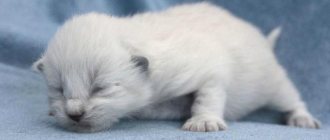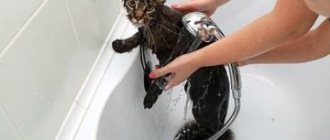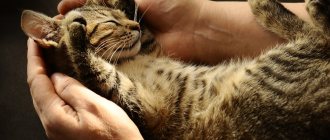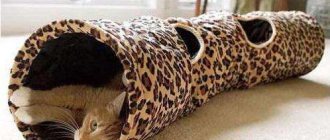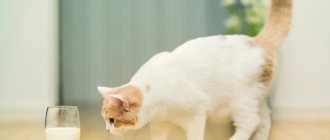Rules for feeding newborn kittens
Teaching a kitten to eat and drink from a bowl is a responsible task for the owner, since a newborn baby, left without a mother and her milk, needs special care and provision of comfortable living conditions.
If such a situation arises, then consultation with a veterinarian is necessary. In this case, newborn kittens are fed from a pipette, and the initial dosage of milk should not exceed more than 2 ml, since they have very small ventricles.
You can teach a kitten to eat from a bowl after three weeks of age, since motor reflexes have formed and he is ready to eat on his own.
Instructions for feeding and introducing complementary foods to newborn kittens:
- after birth, the kitten eats only mother’s milk for the first three weeks (a syringe, pipette with cow’s or goat’s milk is used as a replacement);
- in the period from three weeks to two months, a variety of foods (meat, fish, cereals, legumes) can be introduced into the baby’s diet;
- after four weeks of life, the kitten can be given porridge and pureed vegetables;
- at two months the kitten is ready to eat solid food (bones, cottage cheese, other unground foods);
- after three months, a mature kitten can eat bones, sinews, raw meat, chopped vegetables and fruits;
- After five months, the kitten is ready to eat food that adults eat.
Why does a kitten not drink water well?
A kitten's refusal to drink may indicate that its teeth are changing. This occurs when the animal reaches 3-5 months. The kitten tries not to touch the loose tooth, so it is difficult for him to lap up liquids. Severe pain can cause your pet to eat less of any food. It is better to teach a kitten to drink water before the age of 3 months.
When kittens begin teething, they experience severe itching in their gums and chew on objects. If something gets stuck in a cat's throat, he will not be able to swallow normally and will refuse to drink. Try not to leave small objects on the floor - kittens will definitely try them.
Attention! Wet food already contains a certain amount of water, so the kitten may drink less if it eats spiders.
How to train a kitten to eat on its own
In order to teach a kitten to eat from a bowl on its own, you need to make an effort, depending on whether the baby is growing up with or without its mother.
A mother cat teaches her child to eat adult food, check its temperature, she shows him how to swallow food, break it up correctly, and with her purring invites him to a meal.
If the baby grows up without a mother, then the owner needs to teach the kitten to eat independently. In this case, the most effective method is considered to be giving a personal example (showing the baby how to lap milk from a saucer).
An effective method is to smear food on your finger or pacifier. The kitten, in turn, will lick it off and gradually understand that this is how it needs to be eaten to satisfy its needs.
Before a kitten learns to lap from a saucer, it is important to accompany each meal with the phrase “let’s go eat,” since the animal will form a clear reflex to this phrase in the future.
At the same time, obtaining the expected result, when the kitten, having heard the phrase, immediately approaches the bowl, takes time (at least 2 months of daily training).
How does a cat feed her great-grandchildren?
If a kitten is raised by an adult cat, then it becomes independent in the blink of an eye. For about two months, kittens feed on their mother’s milk, so if their development and adaptation occurs confidently, the cat will wean the kittens off milk much earlier. At the age of 3-4 months, kittens are able to eat independently, separately from their mother.
Normally, kittens can breed a cat for up to 6-8 weeks, and in this case it sounds like you should keep an eye on the cat herself. She must receive proper sleep and rest so that all kittens have enough milk, and it does not lose its beneficial properties. If a cat does not receive what it needs, it quickly becomes exhausted and can get sick. At such moments, the cat’s parental instinct kicks in, and the instinct of self-preservation fades into the background. The cat needs to be taken away from the kittens for a while, its nutrition monitored, vitamins added to its food, or calcium injections given.
Why doesn't it work right away?
Many people wonder why it is not immediately possible to teach a kitten to feed from a bowl on its own and should understand that a small kitten that finds itself in a new family takes a longer time to adapt and needs additional care.
In order for the process of accustoming to food to move much faster, you need to diversify your baby’s diet as much as possible. As a result, his taste characteristics will be formed, and he will begin to eagerly eat from the bowl.
During feeding, the presence of the owner is important, since in such conditions the kitten feels comfortable and eats its portion to the end.
At what age did God tell the kitten to introduce complementary foods?
A kitten growing up without a cat is often simply ready to feed on its own by the age of 3 weeks. This needs to be tested first. You need to pour warm milk into a small saucer with a volume of no more than a tablespoon; if the kitten is ready to eat on its own, it will start drinking it. Of course, the first independent meal will be accompanied by a loud snort and a dirty face, although this is how the kitten will learn to eat without the help of a pipette.
After a few days, you can add a little baby formula to the milk so that the body receives all the necessary vitamins and microelements. Complementary feeding will provide the full energy and development necessary for the growth and good health of the animal.
If feeding with milk is successful, by 6-8 weeks you can instill complementary foods in the form of canned meat, chicken broth or a specialized broth for kittens. Initially, portions of complementary foods should be small; they should be added gradually.
How to quickly train a kitten to eat from a bowl
You can teach a kitten to eat from a bowl, if it is artificial, quite quickly using simple techniques:
- a kitten under 2 months of age does not think very well, so in order for him to understand that there is tasty food in the bowl for him, you need to smear his mouth with the mixture or unobtrusively lower his head into the bowl;
- The feeding bowl should not slide on the floor, and a container of water must be placed next to it. It is better to carry out the procedure at the same time, as the animal quickly gets used to the established routine;
- when feeding, do not exceed the servings of food, as in this case the baby’s feeding schedule may be disrupted;
- if the kitten is hungry, then it constantly squeaks, meows and looks for food in a bowl or in various corners of the apartment.
A few necessary recommendations
It is difficult for your kitten to feed himself if the dishes are awkward or large, so you should choose dishes that are the right size and that are stable on the floor. This way the baby will feel more comfortable and will eat more willingly.
Be sure to read:
A kitten meows: reasons, how to quickly calm it down, what to do when you need veterinary help
Don't forget the following simple rules:
- A saucer of water should be placed near the bowl of food.
- You cannot force a kitten to eat.
- Do not mix dry food with regular food. This can only be done when switching from one food to another.
On a note! The kitten will refuse food that is too hot or, on the contrary, cold . Food should be at room temperature.
How to change a kitten's diet
A variety of diet is provided gradually after the first three weeks of a kitten’s life, which helps improve the functioning of the digestive system, and the baby begins to enjoy eating food.
List of approved products for small kittens:
- low-fat kefir aged three days;
- smoked meats can be used as a flavoring additive to food to develop a stable reflex to food intake in an animal;
- liquid porridges, vegetable purees;
- boiled meat in small pieces.
If more than 5 months have passed since the birth of the kitten, then it can eat a variety of foods in normal quantities, like an adult animal. Mature individuals have well-developed digestion, teeth have formed, so they are completely ready for adult life.
How to feed a newborn baby
An important aspect is to ensure the correct feeding schedule for newborn kittens who are left without a mother. In such cases, it is necessary to follow simple recommendations:
- It is convenient to feed a kitten with cow's milk from a pipette up to 8 times a day (the temperature of the mixture should not exceed 37 degrees). The temperature is checked by pouring a drop of milk onto the back of the hand;
- if the kitten has reached the age of 1 month, then for feeding you can use a regular bottle with a nipple;
- After each feeding of the newborn, it is recommended to massage the tummy to improve digestion (light strokes clockwise);
- A qualified veterinarian can create an individual diet that will help quickly establish the baby’s digestive process.
What to do?
If you have taken into account all the rules for feeding kittens and knowing the reasons why the kitten does not eat, first of all you need to get rid of it. No reason - no problem. If you have ruled out the effects of stress, and the bowl and feeding area are perfectly clean and without any odor, then run to the veterinarian. It's better to be safe than sorry. Have your doctor examine a kitten that doesn't want to eat. If the examination reveals a disease, the veterinarian will prescribe the necessary treatment. Next, we have prepared some tips on what to do if the kitten does not eat anything, which may be useful to you.
Self-medication will not give results; it will only worsen the pet’s condition. Making diagnoses on the Internet is not the best way to solve the problem of kitten starvation. But even during treatment, appetite may not be fully restored.
Bottle with nipple, pipette or nurse cat
A bottle with a nipple, a pipette or a nurse cat is the solution for very tiny kittens. If the kitten is very small, then buy a bottle with a small diameter nipple so that it fits in the kitten's mouth, and a cat milk replacer. Or find a nurse cat. Perhaps one of your friends has recently given birth to a pet, so you can try to attach your starving baby to her. Just let them smell each other first. Some adult animals defend themselves from other people's children.
Don't try to force feed!
This can frighten a kitten who won't eat anything. Yes, sometimes the only way to prevent a small pet from dying of hunger. But this should be a last resort.
Place soft, wet food in a bowl
Only a little. Otherwise if it goes bad. After all, food must be fresh. If you want to offer natural food, you can try adding some boiled fish or lean meat.
When a kitten doesn't eat, he should at least drink
Therefore, put a plate with clean (filtered or boiled) water. If the baby does not know how to lap on his own, then he will have to drink water either through a pipette or through a pacifier, at least in small portions.
No fatty foods
Many people drink the broth. However, this is not the best option, since the body of a meowing fluffy is not yet ready to digest fatty foods. Especially when the hunger strike lasted for several days. A weakened body needs very light food. Yes, when the kitten does not eat food for only one day, and the animal’s age exceeds 2-3 months, then you can try giving it broth through a bottle. Just don’t add salt or add any seasonings. For meat, do not take pork or lamb, this is too fatty meat.
Try finger feeding
Alternatively, try giving from your finger. Drop a little on your finger (water, milk, low-fat sour cream, broth) and bring it to the baby’s nose. If he stubbornly turns away, do not “rape” him. Try a little later (in half an hour or an hour). If a kitten who does not eat from the bowl suddenly licks food from his finger, then drip more. Gradually move your finger closer to the bowl; perhaps the kitten will taste the food from your hands and try to eat from the bowl on its own. It is preferable to use soft food so that you do not need to chew for a long time, just licking it off the bowl would be enough. A good option is canned meat for children. They are without salt, the meat is perfectly chopped, and often they also contain cereals.
Contact the breeder
If you took it from a breeder, then ask him what to do if the kitten does not eat, whether the baby was vaccinated, what the baby was fed before the sale. Perhaps you are offering food that is unusual for him. Some purebred kittens are very fussy about food. Wrong manufacturer, wrong taste, wrong form. Therefore, contact the breeder and find out the details of feeding the baby of the breed you purchased from him.
Do not delay visiting the veterinarian, even if the kitten has started to eat. Let him rule out serious illnesses.
Still have questions? You can ask them to our site's in-house veterinarian in the comment box below, who will respond to them as soon as possible.
Recommendations for training a kitten yourself
Most often, problems with independent feeding in a kitten arise if it is separated from its mother at an early age, since it is she who teaches her offspring to lap from a bowl without problems and in a fairly short time.
If such nuances arise, experts give some recommendations:
- Bowl feeding begins with cow's milk, which is served warm. It is necessary to offer the kitten food and let it smell it. If he is not interested, then you can lightly poke him with his muzzle to fully experience the taste of the product;
- in some cases, the food bowl is not suitable in height, so it is best to purchase it from a special pet store in accordance with the appropriate parameters;
- after the kitten has learned to lap up milk from a bowl, you can gradually switch it to semolina porridge;
- Meat pate for kids is often tried as a new product that can be used during training. At the same time, the reaction to it is ambiguous (some kittens immediately try and eat the product, while others refuse food until they grow up);
- When eating, the kitten must also be given water, since the animal requires mandatory fluid intake, especially after a meal;
- in many cases, small pets love to bathe in a bowl of milk. At the same time, there is no need to limit such actions, since over time, kittens learn to eat well on their own;
- A kitten's normal nutrition can be assessed by the number of trips to the litter box. If they are regular, it means that the pet is well fed, and its digestive system is working stably.
How to teach a kitten to eat solid food on its own
In some cases, problems may arise when introducing solid food into a kitten’s diet, so you need to follow these simple rules:
- You can try placing small pieces of food directly into the kitten’s mouth. This way he will taste the product and subsequently will not refuse it, but will eat it with pleasure;
- As an initial complementary food, you can use dry food, which is pre-soaked in water. The initial quantity should not exceed 2 pieces;
- When introducing solid foods, you need to pay attention to the baby’s taste preferences (some kittens love cottage cheese, while others are delighted with fish). Based on the information received, a daily diet is compiled;
- It is recommended to start introducing solid foods with liquid porridges (semolina or crushed corn grits are considered the best option);
- dry forms are given to small kittens only after all their teeth have formed.
Kittens begin to eat on their own when they reach the age of 1–1.5 months. Before this time comes, you should try to teach your pet to drink milk and gradually diversify its diet by introducing other products.
Age-related features of cat nutrition
The cat feeds its children for two months, however, even despite this, in order for the transition to a normal diet to be successful, the kitten must be fed as soon as the first three weeks of its life have passed. At this time, babies can eat liquid porridge.
https://youtu.be/BZYnaEKrwQQ
When kittens are two months old, their first baby teeth grow in, and solid food can be gradually added to their diet at this time. So, by the age of ten weeks, the pet can eat all types of food, at which time it increasingly moves away from mother’s milk to the regular menu.
Additional Tips
Kittens at a young age eat small amounts of milk, so a regular plastic lid for cans would be a convenient container for them. It is difficult for a kitten to learn to feed itself in a large bowl, since the milk is distributed unevenly, and the animal simply bathes in it.
Milk for feeding should be at room temperature, as too cold or too hot a formula can adversely affect the health of a small pet. You can heat the product using any available methods (microwave, regular heating), but it is important to check the degree of heating itself (no more than 37 degrees).
At first, a pipette, a syringe, or a container for nasal drops are used as a feeding device for a newborn kitten. The container must be thoroughly washed and sterilized before first use.
A kitten that lives with its mother quickly gets used to eating from a bowl after the cat, since she independently ensures that the offspring acquires all the necessary skills. Therefore, it is better to adopt a small pet after two months of age, when it is completely ready for life in a new home and easily adapts.
What kind of water is best to give to a cat?
Tap water is the simplest and most harmless option. But it must be cleaned before being consumed. Many owners of aqua filters forget that the device needs to be constantly changed.
Be sure to read:
How to discourage cats from being tagged: what to do, folk and special remedies
Tap water is the simplest and most harmless option.
Filters wear out and stop doing their job. To clean the liquid from harmful substances, you can leave it in a tightly closed container for 6-8 hours. Running water contains a lot of oxygen; it attracts pets more than bottled or boiled water. This is why many cats love to climb into aquariums: they are always equipped with devices that saturate the water with oxygen.
Drinking fountains are an expensive pleasure, but this device is the most convenient and better purifies the liquid from harmful impurities. The liquid in such devices constantly circulates, enriched with oxygen and cleansed of harmful impurities. Some drinkers have a dome with a hole at the top.
It will be convenient for your pet to lick the dripping liquid. Veterinarians say that using a drinking fountain can quickly teach a cat to drink water.
Many owners, trying to please their pet, aggravate its condition. Boiling rids the liquid of parasites and the smell of chlorine. But when it evaporates, the concentration of salts increases. The resulting sediment mixes with the water and makes it “heavy.” Such drinking will not benefit the animal.
If you are concerned about the health of your family and pets, it is easier to buy bottled water. It's more expensive than pouring it from the tap. But bottled water reaches customers completely purified from harmful substances and parasites.
By looking at reviews, you can be convinced of the quality of a product of a particular brand. You cannot always be sure that the filters are working properly; they need to be constantly changed. Buying bottled water can be even more cost-effective than constantly changing purification devices.
